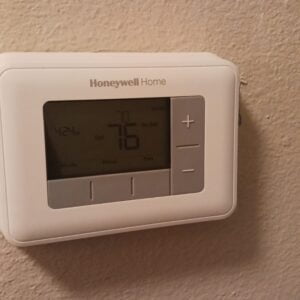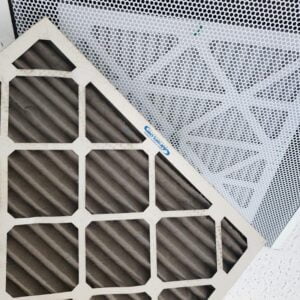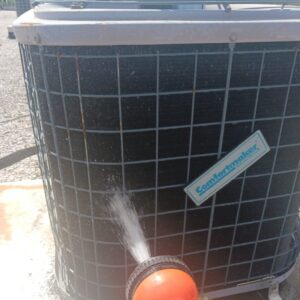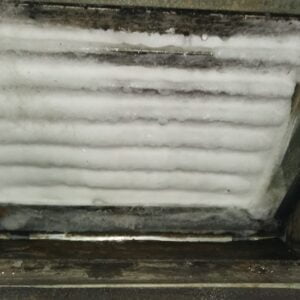What to do if my AC is not working?
Summer is here and it’s time to turn on your AC unit to stay cool and comfortable.
However, what happens when your AC unit isn’t working properly? What to do if my AC is not working? It can be frustrating and uncomfortable, especially during the hot summer months.
Fortunately, there are steps you can take to troubleshoot your AC unit and get it back up and running.
In this blog post, we will discuss what to do if your AC is not working. We’ll provide you with a step-by-step guide on how to identify and fix common AC problems, such as checking the thermostat, cleaning the air filter, and inspecting the outdoor unit. We’ll also offer some additional tips to consider, such as checking for icing on the coils and upgrading to a new AC unit.
If you’ve tried all of these steps and your AC unit is still not functioning properly, it’s important to call in a professional HVAC technician.
We’ll also introduce you to The AC Therapist, a professional HVAC company that provides high-quality AC repair, installation, and maintenance services to homeowners in the Tampa Bay area. With their expertise and commitment to customer satisfaction, you can even call them and ask: What to do if my AC is not working?
10 Easy Steps to Follow when you ask yourself: What to do if my AC is not working?
Follow these 10 easy steps if you ever ask yourself: What to do if my AC is not working?
Step 1: Check the Thermostat
The thermostat is the control center for your AC unit, and it’s important to make sure it’s set correctly. If your AC unit is not producing enough cool air or is not turning on, the first thing you should check is the thermostat. Make sure the thermostat is set to the “cool” mode and the temperature is set lower than the current room temperature.
If your thermostat is a programmable model, check the programming to ensure it’s set correctly. Sometimes, a simple programming error can cause your AC unit to malfunction. If you’re unsure how to program your thermostat, refer to the manufacturer’s instructions or consult with a professional HVAC technician.
If the thermostat is not the issue, you may need to inspect the wiring or circuit breaker for any damage or wear. A loose wire or tripped circuit breaker can prevent your AC unit from turning on or functioning properly. If you’re not comfortable working with electrical components, it’s best to call in a professional technician to handle the repair.
It’s also important to note that some thermostats require batteries to function. If the batteries are low or dead, it can cause your thermostat to malfunction. Check the battery compartment and replace the batteries if necessary.

Check the Thermostat
Step 2: Check the Power
If your AC unit is not turning on at all, the first thing you should check is the power source. Make sure the AC unit is properly connected and that the connection does not have any burned or loose cables.
Next, check the circuit breaker for any tripped breakers. A tripped breaker can prevent your AC unit from turning on. If you find a tripped breaker, turn it off and then back on again to reset it. If the breaker trips again, it may indicate an underlying electrical problem and you should contact a professional HVAC technician to inspect the wiring.
It’s also important to check the power switch on the AC unit itself. Sometimes, the power switch can accidentally get turned off, which can prevent the AC unit from turning on. Make sure the power switch is in the “on” position.
If you’ve checked the power source and the AC unit is still not turning on, it may indicate a more serious problem that requires professional attention. Contact a licensed HVAC technician to inspect and repair the unit.
Step 3: Clean or Replace the Air Filter
A dirty or clogged air filter can cause your AC unit to work harder than necessary, which can lead to decreased efficiency and increased energy bills. It can also cause your AC unit to malfunction or shut down completely. That’s why it’s important to clean or replace the air filter regularly.
How often you need to clean or replace the air filter depends on several factors, such as the type of filter, how often you use your AC unit, and the level of air pollution in your area. A good rule of thumb is to clean or replace the air filter every 30-60 days. However, if you have pets, allergies, or live in a high-pollution area, you may need to do it more frequently.
To clean the air filter, turn off the AC unit and remove the filter from the air handler. Use a soft brush or a vacuum cleaner to gently remove any dirt or debris from the filter, some filters can also be cleaned with water. If the filter is damaged or excessively dirty, it’s best to replace it with a new one. We recommend using disposable filters. With disposable filters, you can rest assured that every time you replace the filter you are getting something clean.
Regularly replacing the air filter not only improves the efficiency and lifespan of your AC unit, but it also improves the air quality in your home by reducing the amount of dust, pollen, and other contaminants in the air.

Clean or Replace the Air Filter
Step 4: Check the Airflow
If your AC unit is producing weak or insufficient airflow, it can be a sign of several issues. In some cases, it may be a simple fix that you can do on your own. Here are some steps to check the airflow:
- Check the air vents: Make sure all the air vents in your home are open and unobstructed. Sometimes, furniture or other objects can accidentally block the air vents, preventing proper airflow.
- Check the ductwork: Leaky or blocked ductwork can also restrict airflow. Inspect the ductwork for any visible signs of damage or blockage. You may need to call in a professional HVAC technician to inspect and repair the ductwork.
- Check the blower motor: If the inside motor is not turning on despite the condenser unit (outside unit) being on, then you are having issues with your blower motor. In most cases, it is recommended to replace the motor.
If you’ve checked these steps and the airflow is still weak or insufficient, it may indicate a more serious issue that requires professional attention. Contact a licensed HVAC technician to inspect and repair the unit.
Step 5: Check the Refrigerant Levels
Refrigerant is the substance that your AC unit uses to cool and dehumidify the air. If the refrigerant levels are too low, it can cause your AC unit to produce warm air or not cool at all. Checking the refrigerant levels requires a bit more expertise and specialized equipment, so it’s best to leave this step to a professional HVAC technician.
Here are some signs that your AC unit may have low refrigerant levels:
- Warm air: If your AC unit is producing warm air or not cooling at all, it may indicate low refrigerant levels.
- Hissing or bubbling sounds: If you hear hissing or bubbling sounds coming from your AC unit, it may indicate a refrigerant leak.
- Ice buildup: If you notice ice buildup on the refrigerant lines or evaporator coil, it may indicate low refrigerant levels.
If you notice any of these signs, contact a licensed HVAC technician to inspect and repair the unit. They will use specialized equipment to check the refrigerant levels and add more refrigerant if necessary. It’s important to note that adding refrigerant is not a DIY job and should only be done by a trained professional. Overcharging or undercharging the refrigerant can cause serious damage to the AC unit and can be dangerous.
Step 6: Clean the Outdoor Unit
The outdoor unit of your AC system is exposed to the elements, so it’s important to keep it clean and free of debris to ensure proper airflow and efficiency. Here’s how to clean the outdoor unit:
- Turn off the power: Before cleaning the outdoor unit, make sure to turn off the power to the AC unit. You can do this by flipping the switch on the electrical panel that controls the AC unit.
- Remove debris: Clear away any leaves, branches, or other debris that may have accumulated around the outdoor unit. Use a soft-bristled brush to gently remove any dirt or debris from the fins of the outdoor unit.
- Hose down the unit: Using a garden hose, gently rinse the outdoor unit to remove any dirt or debris that may be stuck to the fins. Avoid using a pressure washer or high-pressure water stream, as this can damage the fins.
- Clean the fins: If the fins are particularly dirty, you can use a commercial fin cleaner or a homemade solution of mild detergent and water to clean them. Be sure to follow the manufacturer’s instructions or the recipe for the homemade solution, and avoid using any harsh chemicals that can damage the fins.
- Straighten bent fins: If you notice any bent fins, use a fin comb or a small tool to straighten them. Bent fins can obstruct airflow and reduce the efficiency of the AC unit.
- Trim vegetation: Make sure that any vegetation or bushes around the outdoor unit are trimmed back at least two feet to ensure proper airflow.
- Turn the power back on: Once you’ve finished cleaning the outdoor unit, turn the power back on to the AC unit.
Cleaning the outdoor unit is an important step in maintaining the efficiency and longevity of your AC unit. However, if you notice any issues with the AC unit after cleaning it, it’s best to contact a licensed HVAC technician to inspect and repair the unit.

Clean the Outdoor Unit
Step 7: Check for Icing on the Coils
Another common reason for an AC unit to stop working or not cool properly is due to ice buildup on the evaporator coils. This can happen when the airflow is restricted or when the refrigerant levels are low. Here’s how to check for icing on the coils:
- Turn off the power: Before checking the coils, turn off the power to the AC unit. You can do this by flipping the switch on the electrical panel that controls the AC unit.
- Check the evaporator coil: The evaporator coil is typically located inside the air handler unit or in the indoor unit of a ductless mini-split system. Remove the access panel to expose the coil and inspect it for any signs of ice buildup. If you notice ice buildup on the coil, it’s likely that the airflow is restricted or the refrigerant levels are low.
- Thaw the coil: If you notice ice buildup on the coil, turn off the AC unit and let the coil thaw completely before turning it back on. This can take several hours, depending on the extent of the ice buildup. If you have a heat pump system, put the system on heat mode and let it run until it thaws.
- Check the air filter: A dirty or clogged air filter can restrict the airflow and cause ice buildup on the coils. Check the air filter and replace it if it’s dirty or clogged.
- Check the refrigerant levels: Low refrigerant levels can also cause ice buildup on the coils. If you’ve checked the air filter and it’s clean, contact a licensed HVAC technician to inspect and repair the unit.
Preventing ice buildup on the coils is important for maintaining the efficiency and longevity of your AC unit. Be sure to change the air filter regularly and keep the outdoor unit clean and free of debris to ensure proper airflow. If you notice any issues with the AC unit after checking for icing on the coils, it’s best to contact a licensed HVAC technician to inspect and repair the unit.

Icing on the Coils
Step 8: Check the Fan Motor
The fan motor is an important component of the AC unit that helps to circulate air through the system. If the fan motor is not working properly, the AC unit may not cool properly or may stop working altogether. Here’s how to check the fan motor:
- Turn off the power: Before checking the fan motor, turn off the power to the AC unit. You can do this by flipping the switch on the electrical panel that controls the AC unit.
- Access the fan motor: The fan motor is typically located inside the air handler unit or in the outdoor package unit of the AC system. Remove the access panel to expose the fan motor.
- Check for debris: Check the fan blades and the area around the fan motor for any debris that may be obstructing the airflow. Clear away any debris using a soft-bristled brush or vacuum.
- Test the fan motor: Use a multimeter to test the fan motor for continuity. If the fan motor does not have continuity, it may be faulty and will need to be replaced. Also, test for high consumption and if the power has power and it is not running
- Lubricate the fan motor: If the fan motor is making a squeaking or grinding noise, it may need to be lubricated. Consult the owner’s manual or contact a licensed HVAC technician for instructions on how to lubricate the fan motor.
- Turn the power back on: Once you’ve finished checking the fan motor, turn the power back on to the AC unit.
Checking the fan motor is an important step in maintaining the efficiency and longevity of your AC unit. Be sure to keep the fan blades and the area around the fan motor clean and free of debris to ensure proper airflow. If you notice any issues with the fan motor after checking it, it’s best to contact a licensed HVAC technician to inspect and repair the unit.
Step 9: Consider Upgrading to a New AC Unit
If you’ve followed all the steps and your AC unit is still not working properly, it may be time to consider upgrading to a new AC unit. Here are some signs that it may be time for a new AC unit:
- Age: AC units typically last between 10 and 15 years. If your AC unit is approaching or exceeding its lifespan, it may be time to consider upgrading to a new unit.
- Frequent breakdowns: If your AC unit is breaking down frequently and requiring costly repairs, it may be more cost-effective in the long run to replace it with a new unit.
- Rising energy bills: As AC units age, they become less efficient and can cause energy bills to increase. Upgrading to a new, more efficient AC unit can help to lower your energy bills.
- Inconsistent cooling: If your AC unit is not providing consistent cooling throughout your home, it may be time to upgrade to a larger, more efficient unit that can better handle your home’s cooling needs.
- Refrigerant phase-out: R-22 refrigerant, commonly used in older AC units, is being phased out due to environmental concerns. If your AC unit uses R-22 refrigerant, it may be time to consider upgrading to a new unit that uses a more environmentally friendly refrigerant.
Upgrading to a new AC unit can provide many benefits, including increased energy efficiency, improved indoor air quality, and greater reliability. When considering a new AC unit, be sure to consult with a licensed HVAC technician to determine the right size and type of unit for your home’s cooling needs. You may also want to consider a unit with advanced features such as programmable thermostats or zone control to maximize your comfort and energy savings.
Step 10: Call a Professional HVAC Technician
If you’ve gone through all the steps and your AC unit is still not working properly, it’s time to call in a professional HVAC technician. Here are some reasons why it’s important to call a professional:
- Safety: AC units involve electricity, refrigerant, and other potentially hazardous components. A professional HVAC technician is trained to work with these components safely.
- Expertise: HVAC technicians have the knowledge and experience to diagnose and repair AC problems quickly and efficiently. They can also provide guidance on maintenance and replacement options.
- Equipment: HVAC technicians have access to specialized tools and equipment that are needed to properly diagnose and repair AC problems.
- Warranty: If your AC unit is still under warranty, attempting to repair it yourself or hiring an unlicensed technician could void the warranty. A professional HVAC technician can ensure that the repair work is covered under the warranty.
- Cost: Attempting to repair your AC unit yourself or hiring an unlicensed technician can lead to costly mistakes and further damage to the unit. A professional HVAC technician can provide a cost-effective and reliable solution to the problem.
When choosing an HVAC technician, be sure to look for a licensed and insured professional with a good reputation. You can ask for recommendations from friends and family or look for reviews online. A good technician should be able to provide a clear and detailed estimate for the repair work and should be willing to answer any questions you may have.
If your AC unit is not working properly, it’s important to follow the steps outlined above and to call in a professional HVAC technician if necessary. By taking care of your AC unit and having it serviced regularly, you can ensure that it will provide reliable and efficient cooling for years to come.
Did we answer your question?: What to do if my AC is not working?
In conclusion, if your AC unit is not working properly, there are several steps you can take to troubleshoot the issue and get it back up and running. From checking the thermostat to cleaning the air filter and outdoor unit, these tips can help you identify and fix common AC problems.
However, if you’ve tried all of these steps and your AC unit is still not functioning properly, it’s important to call in a professional HVAC technician and ask them: What to do if my AC is not working?. An experienced technician can diagnose and repair any issues with your AC unit, ensuring it operates safely and efficiently for years to come.
Who are you gonna call?
If you’re looking for a reliable and trustworthy HVAC technician, consider working with The AC Therapist. The AC Therapist is a professional HVAC company that provides high-quality AC repair, installation, and maintenance services to homeowners in the Tampa Bay area. With over 20 years of experience in the industry, The AC Therapist has the knowledge and expertise to handle any AC issue you may be experiencing.
Their team of licensed and insured technicians uses the latest tools and techniques to diagnose and repair AC problems quickly and efficiently. They also offer competitive pricing and a 100% satisfaction guarantee on all of their services, so you can have peace of mind knowing your AC unit is in good hands.
In addition to their repair and installation services, the AC Therapist also provides routine maintenance services to help keep your AC unit running smoothly. Regular maintenance can help prevent costly breakdowns, improve energy efficiency, and prolong the lifespan of your AC unit.
If you’re in need of AC repair or maintenance services, consider working with the AC Therapist. They are committed to providing exceptional customer service and ensuring your home stays cool and comfortable all year round. Contact them today to schedule a service appointment or to learn more about their services.









